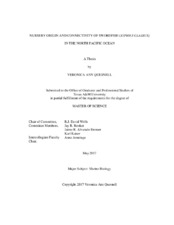| dc.description.abstract | Trace elements in otolith cores of young-of-the-year (YOY) swordfish, Xiphias gladius, were used as natural tracers to predict the nursery origin of sub-adult and adult swordfish sampled from three foraging grounds in the North Pacific Ocean (NPO). First, otolith core chemistry (proxy for nursery origin) was used to evaluate nursery-specific elemental signatures in YOY swordfish. Sagittal otoliths from YOY swordfish were collected from 2000 to 2005 among four regional nurseries in the NPO including Central Equatorial North Pacific Ocean (CENPO), Central North Pacific Ocean (CNPO), Eastern Equatorial North Pacific Ocean (EENPO), and Western North Pacific Ocean (WNPO). Otolith core trace element concentrations of calcium (43Ca), magnesium (24Mg), strontium (88Sr), and barium (138Ba) were measured and quantified using laser ablation inductively coupled plasma mass spectrometry (LA-ICP-MS). Univariate tests indicated that three element:Ca molar ratios (Mg:Ca, Sr:Ca, and Ba:Ca) were detectable and significantly different among nurseries. Sr:Ca ratios were higher in individuals collected from the CENPO while Mg:Ca ratios were higher in individuals from the CNPO. Overall nursery classification success from quadratic discriminant analysis of YOY swordfish to their nursery of collection was 72%. Next, otolith core chemistry of sub-adults and adults collected from three foraging grounds where targeted fisheries exist (Hawaii, California, and Mexico) was examined to calculate nursery-specific contribution estimates. Mixed-stock analysis indicated that the CENPO nursery contributed the majority of individuals to all three foraging grounds (Hawaii 45.6 ± iii 13.2%; California 84.6 ± 10.8%; Mexico 64.5 ± 15.9%). Results from this study highlight the importance of the CENPO nursery to the NPO and provides researchers and fisheries managers new information on connectivity of the Pacific swordfish population in the NPO. | en |


